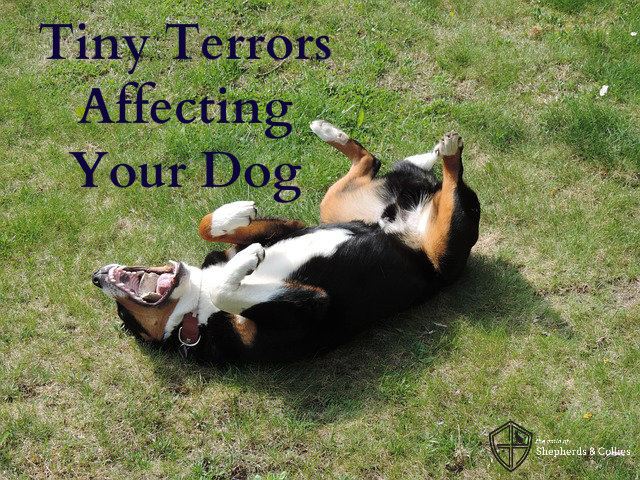Tiny Terrors Affecting Your Herding Breed Dog: The Dangers of Fleas
These Tiny Terrors Can Stop Your Herding Breed Dog in Its Tracks
Fleas and Your Herding Dog ...
If there’s one thing that will downshift your dog from hyper-speed to halt in milliseconds, it’s a flea. Fleas, the tiny terrors that they are, have long been the bane of dog ownership—often considered part and parcel of the doggie package. The humorous image of a dog sitting down, leg poised above its head, eyes bright in anticipation of a good, solid scratching has become so ingrained in our collective dog mind that it seems unlikely to own one without owning a whole host of the other.
What is a Flea? How do Fleas Survive?
Fleas, in the event that you have not been formally introduced, are ectoparasites. An ectoparasite is an organism that gets its sustenance from another creature, and while many parasites live internally, an ectoparasite finds its home on the exterior of the host animal. Worldwide there are over 2,000 types of fleas; North America is home to about 300 varieties. There are fleas that are specific to certain animals, such as poultry, ground squirrels, and rabbits. The most common flea found amongst dogs and cats is the cat flea (Ctenocephalides felis).
The adult cat flea reaches a maximum of about 1/8 inch long. This makes average viewing difficult, but if you were able to get out your magnifying glass you would see a flat, usually reddish-brown, six-legged, wingless insect. Capable of jumping over 1/2 foot in the air, the flea is indeed designed for jumping. Similarly, they are equipped with piercing-sucking mouthpieces—a sort of needle/straw apparatus that allows them to suck up to 15 times their own weight in blood. The body of the flea is “laterally compressed” making it thin enough to slide through the most complicated of your dog’s cowlicks. You may have noticed that it is virtually impossible to squish this insect. That is because the exterior of the flea is composed of hard shells call sclerites, which are essentially a protective exoskeleton. The cat flea is unusual in that it lives its entire life-cycle on its host. So, your dog is not only the flea’s kitchen, but his bedroom, nursery, etc. The big problem is the nursery—female fleas lay up to 50 eggs per day. Good luck noticing, however, as the eggs are translucent and 1/32 inch big—nearly invisible.
In general, fleas inhabit a specific animal, but it is important to remember that they are opportunistic. If a ground squirrel flea happens to land on your dog’s back, he is not going to say ‘no’ to lunch. Herding dogs, who find themselves in close proximity to birds, squirrels, rabbits and other field animals, are susceptible to a variety of flea types. This can leave your dog wide open to a number of conditions carried by fleas such as: tapeworms, Yersinia pestis (the plague), Rickettsia, myxomatosis, Bartonella and Murine typhus. Despite its tiny size, the fact that the flea survives on blood makes it a perfect carrier for many illnesses that can affect dog and human alike.
Fleas thrive in warm, humid conditions. Once the thermometer hits 70°F, the flea is able to quickly breed and proliferate. Despite this, the onset of winter should not mean your flea eradication system can be put on hold - fleas are quite capable of taking advantage of your indoor heating system and set up shop. For this reason, experts highly recommend a year-round approach to flea management.
How Do I Know if My Dog Has Fleas?
The most obvious sign that your dog has fleas is continual scratching, biting and licking the skin. Sometimes you can even hear your dog from the back room. His shiny white chompers are click-clacking away. You just think he has an itch, but it’s worse than that—he’s got fleas. Your dog may develop red, hairless patches which are called ‘hot spots.’ Close inspection may show gritty, black ‘flea dirt’ which is a nice word for flea excrement. While you’re getting your hands dirty, you may want to look for tapeworms—search for small, rice-shaped objects in your pet’s feces and under his tail. Using a fine-toothed flea comb on your dog’s fur is beneficial; often you will catch a flea or two in just a few swipes.
Dogs that are sensitive or allergic to flea bites will show more dramatic symptoms, such as hair loss and irritated skin. Left untended, these spots can become sites for a secondary bacterial infection. As mentioned earlier, fleas are capable of extricating quite a bit of blood—dogs with infestations may have pale gums which could indicate anemia and/or tapeworms. Anemic dogs have pale gums, low body temperature and may exhibit listlessness. Puppies often have an immature immune system and fewer red blood cells; for them, anemia can be life threatening.
Getting Rid of Fleas and Preventing Fleas
Because your dog is the source, your first line of attack must be at the dog level. Flea medication is an important part of your plan, and when it comes to your herding breed dog, you should make a trip to your veterinarian to discuss the best type of prevention for your dog. When conversing with your veterinarian, be sure to mention any other medications or products that your dog is using. Herding breeds are at high risk for having the MDR1 mutation. Dogs that have this genetic trait are sensitive to a number of commonly used medications. Getting checked for this disorder is not difficult, but it is vital, because exposure to certain medications can cause severe symptoms in your dog. When conversing with your veterinarian, make sure to mention any other medications or products that your dog is using. Once your dog is set up with a “flea abatement” plan, it is important to keep him on a consistent treatment schedule.
Many dogs, particularly the herding breeds, may have an aversion to “fussing” and may balk at your grooming efforts. Our Border Collie, Violet, politely declines at the mention of the words “brush,” “comb,” or “bath.” She is not oppositional, but she gives a long, withering look as she silently removes herself from the room. Nevertheless, daily grooming, especially using a flea comb, is one of the best ways to keep on top of errant fleas.
Getting rid of fleas in the home is your next step. Aim first for your dog’s bed and anything in close proximity. Carpeting, blankets, and fuzzy toys are havens for fleas and their brethren. Wash anything that comes into contact with your dog at least once weekly—there may be no evidence of fleas, but your dog’s favorite fuzzie may be harboring eggs and larvae. Carpeting is a sanctuary for fleas, eggs, larvae, and pupae. Larvae often form cocoons in carpeting and are known to emerge when pressure is applied to the floor. Imagine that as you and your dog pad across the carpet! Vacuuming is an absolute necessity where carpet is concerned. Remember to discard vacuum bags frequently, closing the bag tightly and depositing it into a closed trash container.
You can discourage fleas from inhabiting your garden and backyard by mowing or trimming long grass and removing debris. Fleas love the areas that your dog inhabits—usually shady spots where weeds provide a good hiding spot. Fleas may be numerous and mighty, but preventing and managing flea populations is not complicated—it just requires diligence, consistency, and much to your dog’s chagrin, a regular grooming!
Sources:
~Rust, M.K. Pest Notes: Fleas, Publication 7419. University of California Agriculture and Natural Resources, Integrated Pest Management System. September 2010. http://www.ipm.ucdavis.edu/PMG/PESTNOTES/pn7419.html
~Kvamme, Jennifer. Common Fleas that Affect Dogs and Cats. Pet M.D. n.d. http://www.petmd.com/dog/parasites/evr_multi_common_fleas_dogs_cats
~Fleas on Dogs: What to Look For. WebMD. http://pets.webmd.com/dogs/guide/fleas-dogs-what-look-for
~Parasites: Dipylidium Infection (Also Known as Dog and Cat Flea Tapeworm). Centers for Disease, Control and Prevention. January 10, 2012. http://www.cdc.gov/parasites/dipylidium/faqs.html
Article By:
Andrea Peck







